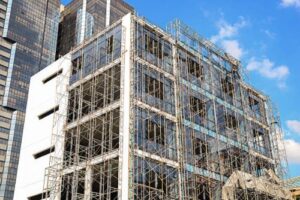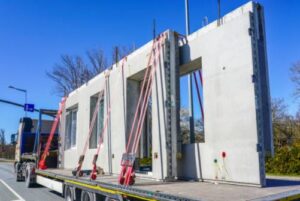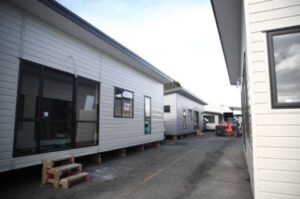
The top challenges to widespread modular construction adoption
 In recent years the construction industry has been diligently fighting against its reputation for being behind schedule and over budget with new technologies and innovations, such as modular construction. Because construction of modular buildings can occur simultaneously with the site and foundation work, resulting in a reduced construction schedule, projects can be completed 30 percent to 50 percent sooner than traditional construction. And since nine out of 10 projects worldwide experience cost overruns, modular construction could reverse this long-running trend.
In recent years the construction industry has been diligently fighting against its reputation for being behind schedule and over budget with new technologies and innovations, such as modular construction. Because construction of modular buildings can occur simultaneously with the site and foundation work, resulting in a reduced construction schedule, projects can be completed 30 percent to 50 percent sooner than traditional construction. And since nine out of 10 projects worldwide experience cost overruns, modular construction could reverse this long-running trend.
Modular construction involves assembling parts of a building in a factory setting before shipping them to the construction site for final assembly. Doing most of the work in a controlled environment can drastically reduce time and costs. One firm used modular construction to finish an apartment building in less than 90 days when traditional construction would’ve taken more than 140.
Since clients want partners who can keep tight deadlines, this speed can help companies secure future projects. Minimizing costs will help improve profits. Despite all these benefits, though, modular construction adoption remains low. Here are the top five reasons why.
1. Lack of familiarity and expertise
 Perhaps the most significant barrier to the widespread adoption of modular construction is its novelty. Modular construction is a radically different approach to traditional methods, which may dissuade firms from engaging in it. Industry professionals are more likely to stick with what they know than attempt something unfamiliar and intimidating.
Perhaps the most significant barrier to the widespread adoption of modular construction is its novelty. Modular construction is a radically different approach to traditional methods, which may dissuade firms from engaging in it. Industry professionals are more likely to stick with what they know than attempt something unfamiliar and intimidating.
As a result of this hesitance over trying new things, there are relatively few firms with experience in modular construction today. Consequently, project stakeholders may encounter difficulty in finding contractors that can provide these services for them. This lack of expertise, combined with the ongoing industry labor shortage, could slow modular’s growth at first.
2. Upfront costs
Early modular projects’ success indicates that these methods could cut costs by 20 percent overall. At the same time, upfront material costs may be higher than conventional construction techniques. Modular projects rely on faster purchases and shorter completion times, which typically involve higher expenses. This could scare some companies away.
Modular construction may also involve a higher level of automation, which improves productivity but comes with a greater upfront cost. These initial expenses may be too high for some companies to feel comfortable with. It could take additional projects demonstrating the overall savings to convince more people to adopt it.
3. Logistical complications
 Modular construction also involves more logistical challenges than traditional methods. Companies have to ship large modules to work sites via truck, which can be dangerous. Costly accidents could occur during transportation, and construction firms may need to pay more for insurance.
Modular construction also involves more logistical challenges than traditional methods. Companies have to ship large modules to work sites via truck, which can be dangerous. Costly accidents could occur during transportation, and construction firms may need to pay more for insurance.
Standard loaded tractor-trailers take 20 percent to 40 percent farther to stop than cars, and trucks carrying modules are likely even heavier. Risks posed to other drivers aside, the modules themselves could incur damage during transport. Overall time and cost savings make up for these risks, but they could still be an initial barrier for many firms.
4. Design restrictions
Not all roadblocks to modular construction adoption are so severe. Some are purely a matter of aesthetics. Since modular buildings must come in mostly prefabricated rooms, it limits design choices. They have to be small and conveniently shaped enough for safe transport and assembly.
For example, modules can be no larger than a shipping container if coming from overseas. As a result, modular construction wouldn’t be an ideal fit for larger, more expensive buildings. The more unusual the shape of a design, the more challenging it would be to fit together with other modules.
5. Complexity
 While modular construction seems straightforward enough at first, it involves complex planning upfront. There’s more to consider in modular architecture, such as planning how all the modules can fit together safely and conveniently. This complexity may intimidate some construction firms from attempting to use these methods.
While modular construction seems straightforward enough at first, it involves complex planning upfront. There’s more to consider in modular architecture, such as planning how all the modules can fit together safely and conveniently. This complexity may intimidate some construction firms from attempting to use these methods.
This added complexity means modular fabrication is a front-heavy process, which is unusual for construction. It saves time in the long run, and tools like BIM can help streamline the design phase, but it may still take time for the industry to come to terms with these techniques.
Modular construction has high potential, but challenges remain
If modular construction becomes mainstream, the construction industry will transform into a more efficient, cost-effective sector. While modular projects’ advantages are promising, reaching those benefits at a wide scale will take time.
Several roadblocks remain between modular construction and widespread adoption. As additional projects pop up, more firms will understand its benefits and try it for themselves. This transition will likely be slow, but it’s a necessary one.






